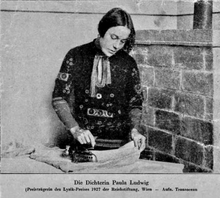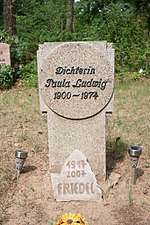Paula Ludwig
Paula Ludwig (born January 5, 1900 in Feldkirch ; † January 27, 1974 in Darmstadt ) was an Austrian writer and painter .
Life
Paula Ludwig was born in the then dilapidated Schlösschen Amberg in Altenstadt near Feldkirch. The father, a Silesian carpenter, separated from his family at an early age and the mother, who came from Austria, moved to Linz with her nine-year-old daughter and earned a living for herself and the three children by sewing. It was not until the mother died in 1914 that the father took the children to Wroclaw . Paula Ludwig recorded these first 14 years in the “Book of Life”. Paula's wish was to become an actress. She had to earn her own living as a maid and atelier assistant in a painting school. As a member of the Breslau Poetry School , she presented her first poems. In 1917 she gave birth to an illegitimate son, Siegfried (1917–2007), called "Friedel". For the first few years she lived with her child in a home for single young mothers in Munich - Nymphenburg , which was run by the Red Cross . She continued to work as a maid, nude model and prompter at the Münchner Kammerspiele . She is in the circle of Stefan George , who also includes the poet Else Lasker-Schüler . She was friends with Klaus Mann and especially Erika Mann , and got to know authors of Expressionism. A friendship with Waldemar Bonsels , whose book “India Tour” had caused a sensation in 1916 and became significant for Paula Ludwig's lyrical world of images , developed for years . The friends urged her to publish poems and drawings. As early as 1921, the Munich art magazine Ararat published reproductions of her watercolors. For a while, Paula Ludwig earned her livelihood solely by selling her pictures and with arts and crafts.
After four years in Munich, following a movement by artists and writers, she moved to Berlin with her son in 1923. At first Paula Ludwig lived in a small dwelling at Hallescher Tor, later in a room on Kurfürstendamm 177 next to the studio on the 5th floor. In mid-1927 she moved into a spacious studio at Kurfürstendamm 112. During this time she was on friendly terms with Bertolt Brecht , Kurt Tucholsky , the brothers Eduard and Carl Zuckmayer and Joachim Ringelnatz, among others . Waldemar Bonsels also lived in Berlin at this time. She began a passionate love and work relationship with Yvan Goll . The correspondence between the two is in the German Literature Archive in Marbach. The relationship prompted Yvan Goll to write the "Malay Love Songs". In 1925 she met the judge and writer Friedrich Koffka , with whom she entered into a relationship that lasted until 1930. She dedicated her volume of poetry, Himmlische Spiegel, published in 1927, to Koffka. Whether the separation - despite previously forged marriage plans - was more due to the fact that the illegitimate mother Ludwig was considered inappropriate for Koffka's family, or because of Koffka's reluctance himself, is controversial.
Between 1927 and 1935 her volumes “Der himmlische Spiegel”, “Demarken Gott. An annual poem of love ”,“ Book of Life ”and“ Dreamscape ”.
In 1927 she enrolled her son in the reformed educational rural education home, Schule am Meer , founded and directed by Martin Luserke , which was very musically influenced. Carl Zuckmayer's brother Eduard worked there as a music teacher from 1925.
She did not feel at home in National Socialist Germany. Although she was neither racially nor politically persecuted, she lived in Ehrwald in Tyrol from 1933 . In 1938 she fled - threatened because of her advocacy for German Jews - via Switzerland to France and in 1940 to Spain, Portugal and finally Brazil , where her sister lived. The critic of the regime remained in exile in Rio de Janeiro and São Paulo from 1940 to 1953 and made her way as a painter.
During this time, "Traumlandschaft" was banned because of a thank you to an American sponsor. During the 13 years in exile, she was unable to continue her writing activities. She earned a living with flower presses and pictures made from them. When she returned to Europe in 1953, her health was in poor health and she was dependent on alcohol. In Austria her citizenship was not recognized and in Germany she was accused of anti-Semitism because she referred to the German translation of Goll's “Chansons malaises”, which Paul Celan was supposed to translate. She lived penniless, at times homeless, in Götzis and Düsseldorf .
Günther Leitz supported them. Both knew each other from the 1920s / 1930s, when she traveled to school by the sea on the North Sea island of Juist when she wanted to visit her son there, the schoolmate from Leitz.
In 1956 she moved to her son Friedel, who worked as a photographer in Wetzlar , in Reinermannstrasse in the Wetzlar city center. Ludwig lived there in seclusion until 1970. She died in Darmstadt on January 27, 1974 and found her final resting place in the forest cemetery there (grave site: R 14f 4/10). The grave has been one of the honor graves of the city of Darmstadt since 1975 .
Awards and honors
- 1962: Georg Trakl Prize
- 1972: Prize of the Austrian Writers' Association
- In Darmstadt a square was named after Paula Ludwig.
- A path is named after her in the Munich district of Moosach .
- In Götzis the Paula-Ludwig-Weg bears her name.
exhibition
In the summer of 2004, the Vorarlberg State Museum, in cooperation with the Franz-Michael-Felder-Archive , showed an exhibition about the Vorarlberg poet and painter Paula Ludwig. The focus was on the artist's paintings and drawings, which were presented to the public for the first time on this scale.
The exhibition presented a cross-section through the entire painting work of Ludwig from the beginnings in Munich to the last few years in Darmstadt. At the same time, the stations of her life and literary work from Altenstadt to Linz, Breslau, Munich, Berlin, Ehrwald, Paris, Gurs, Mury, São Paulo, Wetzlar and Darmstadt were shown in selected biographical and literary documents, companions and friends such as Hermann Kasack came , Waldemar Bonsels, Bert Brecht, Yvan Goll, Ina Seidel, Carl Zuckmayer and Erika Mann have their say. In this way, the exhibition documented Paula Ludwig's multifaceted involvement in the trends of her time.
The material for the exhibition came from the artist's extensive estate, which is kept in the Franz Michael Felder archive of the Vorarlberg State Library.
Theatrical documentary
On April 6, 2018 the world premiere of the play Paula Ludwig Friendships and Ways of the Theater Group Art and Drama by and with Friederike Pöhlmann-Grießinger and Roland Eugen Beiküfner took place in the Theater am Saumarkt in Feldkirch . It is the third and final part of the literary theater series Trilogy of the forgotten writers of art and drama. This performance was musically framed by Johanna Eras on cello and Thomas Müller on violin. The German premiere took place on June 21, 2018 in Nuremberg. The violinist Boris Loncar from Sarajevo has been accompanying the production since May 11, 2019.
Works (selection)
Poetry
- The blissful trace , Munich: Roland Verlag, 1919
- The heavenly mirror , Berlin: S. Fischer Verlag, 1927
- To the dark god. An annual poem of love , Dresden: Wolfgang Jess Verlag, 1932; Munich: CH Beck, 2015, ISBN 978-3-406-60731-8
- Poems , Hamburg: Heinrich Ellermann Verlag, 1937 (= The poem. Volume 3, episode 13/14)
- Poems. A selection from the period from 1920 to 1958 , Ebenhausen near Munich: Verlag Langewiesche-Brandt KG, 1958
- Versensporn - Booklet for Lyrical Charms No. 38 , ed. by Tom Riebe, Jena: Edition POESIE SCHMECKT GUT, 2019. [100 copies]
prose
- Dream landscape , drawings by Fritz Kuttner, Berlin: Waldemar Hoffmann Verlag, 1935 DNB
- Dream landscape , new edition, Leipzig: Staackmann 1938 DNB
- Dreams. Records from the years 1920-1960. Ebenhausen near Munich: Langewiesche-Brandt publishing house, 1962
- Book of life (autobiography), Leipzig: Staackmann 1936
literature
- Barbara Glauert-Hesse (Ed.): "I die my life". Iwan Goll, Paula Ludwig. Letters 1931–1940. Literary documents between art and war . Limes-Verlag, Frankfurt am Main 1993.
- Barbara Glauert-Hesse (ed. And author of an afterword): Claire Goll , Yvan Goll , Paula Ludwig. "Only once more will I be unfaithful to you". Correspondence and records from 1917 to 1966 . Wallstein Verlag, Göttingen 2013, ISBN 978-3-8353-1046-9 .
- Manfred Bosch : "I want to practice on the departure of the migratory bird ...". Paula Ludwig - from childhood in Vorarlberg to exile in Brazil . In: Bohème on Lake Constance . Bottishofen 1997.
- Ulrike Längle : “I am a homeless poet” . Salzburg and Vienna 1993.
- Helmut Swozilek (Ed.): “I look at myself from a thousand mirrors”. Paula Ludwig. 1900-1974. Poet, painter . Exhibition, Vorarlberg State Museum and Franz Michael Field Archive of the Vorarlberg State Library, Bregenz, July 24th – 26th. September 2004. Vorarlberger Verlagsanstalt, Bregenz 2004. ISBN 3-901802-20-7 [This book contains a bibliography of the writings of Paula Ludwig (pp. 131–156) and a short biography (pp. 157–159).]
- Kristian Wachinger: Ludwig, Paula. In: New German Biography (NDB). Volume 15, Duncker & Humblot, Berlin 1987, ISBN 3-428-00196-6 , p. 435 f. ( Digitized version ).
- Irene Jung: Wetzlar women in the 20th century . Ed .: Women's Office of the City of Wetzlar. Wetzlar 2009, p. 51-53 .
- Gisela Brinker-Gabler, Karola Ludwig, Angela Wöffen: Lexicon of German-speaking women writers 1800–1945. dtv Munich, 1986. ISBN 3-423-03282-0 . P. 205.
Web links
- Literature by and about Paula Ludwig in the catalog of the German National Library
- Vita at lyrikwelt
- Vorarlberg State Museum
- Paula Ludwig's estate in the Franz Michael Felder archive of the Vorarlberg State Library
- Paula Ludwig , on Planet Lyrik on May 28, 2012, accessed on September 21, 2015
Individual evidence
- ↑ Barbara Hartlage-Laufenberg, two lawyers, two writers, two Jews - Friedrich Koffka and Kurt Messow . In: Neue Juristische Wochenschrift , issue 11/2013, p. 749.
- ↑ Heide Hellwig: "Whether nobody calls me" - the life of Paula Ludwig . CH Beck. Munich S. 117. 2004. ISBN 978-3-406-61067-7 .
- ↑ Ludwig, Paula. Hessian biography. In: Landesgeschichtliches Informationssystem Hessen (LAGIS).
- ↑ Information board at the main entrance of the Waldfriedhof Darmstadt
- ↑ Darmstädter Echo, Tuesday, February 19, 2019, p. 10.
- ^ Paula Ludwig 1900-1974
| personal data | |
|---|---|
| SURNAME | Ludwig, Paula |
| BRIEF DESCRIPTION | Austrian writer and painter |
| DATE OF BIRTH | January 5, 1900 |
| PLACE OF BIRTH | Feldkirch |
| DATE OF DEATH | January 27, 1974 |
| Place of death | Darmstadt |



